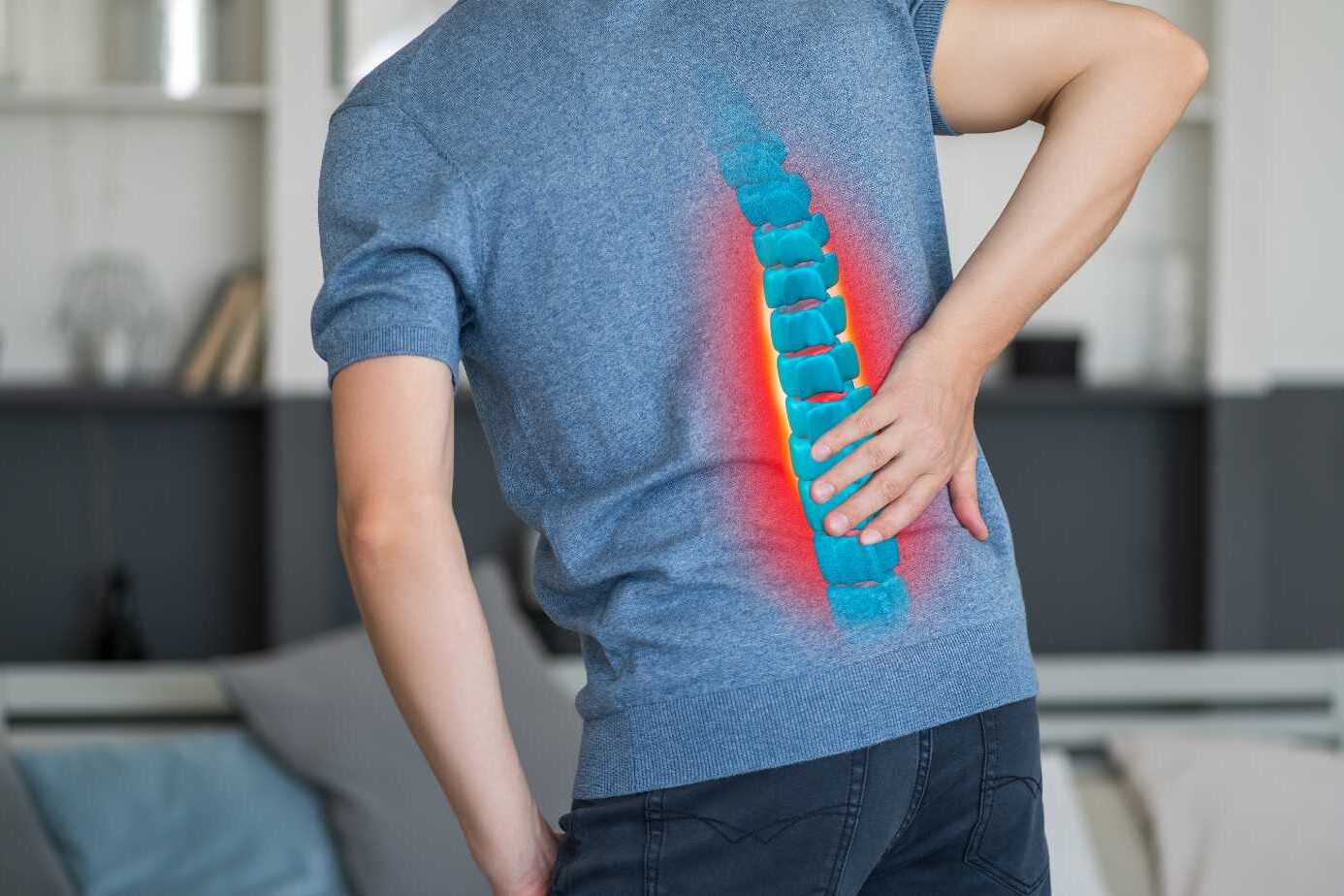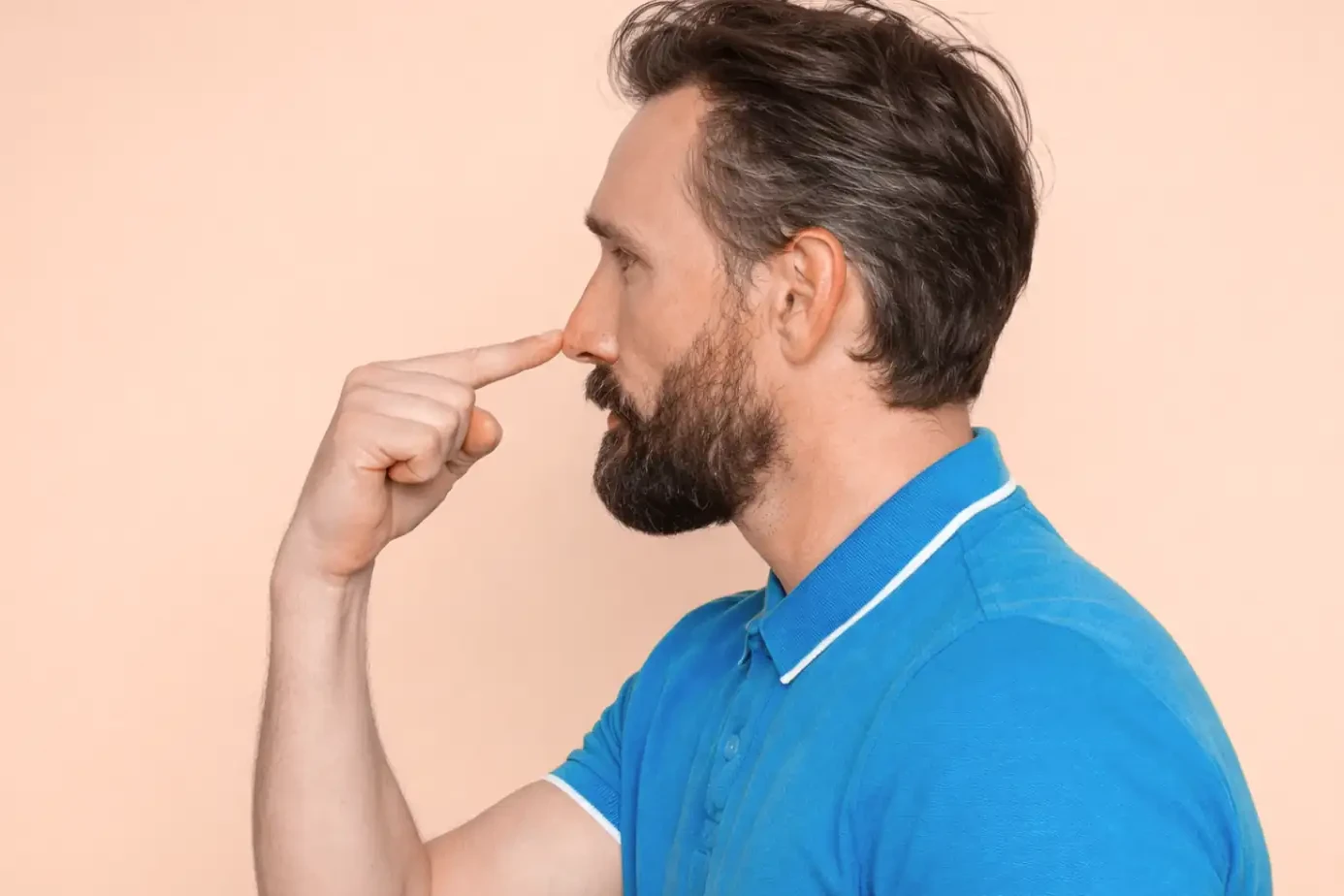Lumbar radiculopathy, or sciatica, affects around 5% of Americans. It is when a spinal nerve root is compressed or irritated. Thankfully, many treatments can help without needing surgery. We’ll look at the options to treat lumbar radiculopathy.
This issue often starts in midlife. Men in their 40s and women in their 50s and 60s are usually affected. Women in hard-working jobs have a higher risk, while there’s more men in the general population. Degenerative spondyloarthropathies cause this problem.
We have many ways to treat lumbar radiculopathy. Both simple methods and more serious procedures can help. We’ll talk about how to find out what’s causing the issue, what basic treatments to try first, and what to do if those don’t work.
Table of Contents
ToggleUnderstanding Lumbar Radiculopathy
Lumbar radiculopathy happens when a nerve in the lower back gets pressed or irritated. A herniated or bulging disc and bone spurs are common causes. This issue is also known as sciatica. It causes pain, numbness, and weakness in the lower back, hips, and legs.
Causes and Risk Factors
Causes for this condition include issues like disc herniation or arthritis. It’s often linked to getting older. Being overweight, sitting or standing badly, and heavy jobs make it more likely. In some cases, women with tough jobs, like in the military, have a greater risk.
Symptoms and Clinical Presentation
This problem usually starts in midlife. Men in their 40s and women in their 50s and 60s are more often affected. Signs include back pain, leg pain, and numbness. Muscle weakness can also happen. Where the symptoms show up depends on which nerve root is affected. The lower back is usually the main area affected.
Diagnostic Workup
Diagnosing lumbar radiculopathy starts with a detailed look. Your healthcare provider will check your muscles and how you feel things. They’ll also test your reflexes to see how your nerves are doing. This physical exam is key to figuring out what’s wrong.
Imaging Tests
Imaging tests like MRIs or CT scans help find where the nerve is getting pressed. MRIs are best for looking at nerve problems from herniated discs. But, if your symptoms are very serious, you might need an MRI right away. This could be if you can’t control your bowels or bladder, or if a tumor is suspected.
CT scans are great for seeing the bones, but not so much for soft tissue like discs. A myelogram, where they put dye in your spine, is done when surgery might be needed. This test is for people whose condition is getting worse, and other tests haven’t helped much.
Electrodiagnostic Studies
Tests like EMGs and nerve studies show if radiculopathy is present and where. They look at how well your muscles and nerves are working. These tests are key, especially if the imaging tests don’t give a full answer.
Your healthcare provider will use a mix of exams and tests to figure everything out. With the right information, they can make a clear diagnosis. Then, they can decide on the best plan to help you.
Conservative Treatment Approaches
Managing lumbar radiculopathy often starts with non-surgical methods. These treatments focus on the cause and offer relief without surgery. Let’s look at some top conservative ways to treat lumbar radiculopathy.
Physical Therapy and Exercise
Physical therapy and specific lumbar radiculopathy exercises are crucial for treating lumbar radiculopathy conservatively. This helps strengthen spine-supporting muscles, boost mobility, and cut down nerve irritation. Your physical therapist might craft a program with stretching, core work, and posture correction. These can ease your symptoms and ensure a healthier back for the long term.
Medication Management
Medications also have a big role in conservative lumbar radiculopathy treatment. Anti-inflammatory drugs, muscle relaxants, and pain relievers can ease symptoms and inflammation. Make sure to talk with your doctor about your medicine plan to avoid side effects from long-term use.
Alternative Therapies
Some folks might get relief from alternative therapies for lumbar radiculopathy. Acupuncture, chiropractic care, electrical stimulation, and meditation could help reduce its impact for some. While their success varies, these methods might be useful when part of a broader treatment plan.
Working closely with your doctor is key for managing lumbar radiculopathy conservatively. By combining physical therapy, medication, and alternative treatments, you can often get relief without surgery.
Epidural Steroid Injections
Epidural steroid injections are often used to help with lumbar radiculopathy. They place anti-inflammatory medicine right where it’s needed. This can cut down on swelling and ease the pain. In the initial stage of lumbar radiculopathy, these injections work well. They’re a good option to try before considering surgery.
Doctors have been using epidural steroid injections for sciatica since the 1930s. The method to treat back pain with these injections was first described in 1953. Over time, these injections have gained popularity as a way to manage lumbar radiculopathy.
But, there is a chance that the medicine might not reach the right spot in about 30% of cases. This happens with injections done without imaging guidance. Using imaging for the injections ensures the medicine hits the exact spot. This gives the best results and helps doctors check if the injection worked.
A traditional type of epidural injection shows success about 69.2% of the time. A different method, called the preganglionic approach, works about 90% of the time. The difference in how well these two methods work is almost significant, with a p-value of 0.056.
Medical research shows that lumbar epidural injections may reduce pain for less than three months. But, a transforaminal epidural spinal injection (TFESI) might offer pain relief for up to 20 months. The success rate for TFESI is around 75.4%.
Comparing the two, studies find that TFESI is better than the blindly done interlaminar approach at different times. Injections through the foramina have shown to be more effective. They work better than blind interlaminar injections and the caudal method when guided by fluoroscopy.
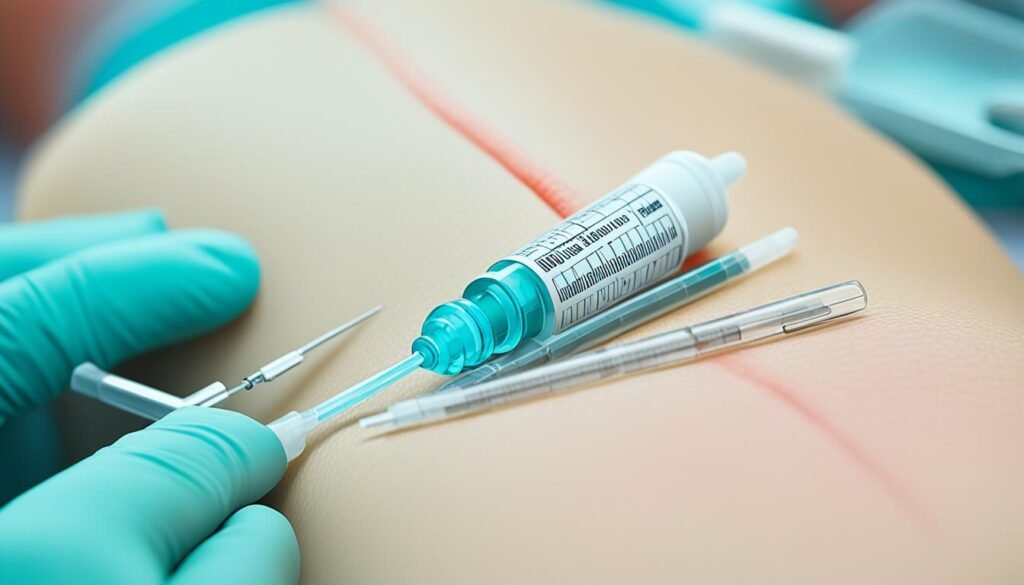
Overall, epidural steroid injections can greatly help with managing lumbar radiculopathy. They are most effective when combined with other treatments. Always remember, choosing imaging-guided injections can make a big difference. It ensures the medicine reaches the right place, giving the best possible result.
Trigger Point Therapy
Trigger point therapy aims to relieve pain in those with chronic lumbosacral radiculopathy. It focuses on treating specific spots of muscle tightness, known as trigger points. These areas often worsen the symptoms of trigger point therapy for lumbar radiculopathy. This method aims to reduce pain and boost function for these patients.
A recent study showed positive results. Within 10 days, patients felt less pain after receiving trigger point injection therapy. This means that using trigger point therapy for lumbar radiculopathy as part of a larger treatment plan could be very helpful.
It’s important to know that trigger point therapy for lumbar radiculopathy is not a cure-all. But, it can complement other treatments like physical therapy and medications. By discussing this option with your doctor, you can see if it’s right for you and your symptoms.
Lumbar radiculopathy treatment
If simple treatments don’t work well enough, doctors might look at more intense ways to handle lumbar radiculopathy. There are things they can do before surgery. For example, epidural steroid injections and trigger point therapy can help a lot. But sometimes, surgery becomes the best option.
Non-Surgical Options
Options like epidural, facet, and transforaminal injections can ease symptoms for quite a while. These treatments help with inflammation and stop nerve irritation. Many people see big improvements from them.
Surgical Interventions
If things don’t get better after four to eight weeks of trying other treatments, surgery can be considered. Operations like discectomy, laminectomy, and spinal fusion are common for lumbar radiculopathy. A big research study called the Spine Patient Outcomes Research Trial (SPORT) showed surgery might work better than non-surgical methods, but not always by a lot.
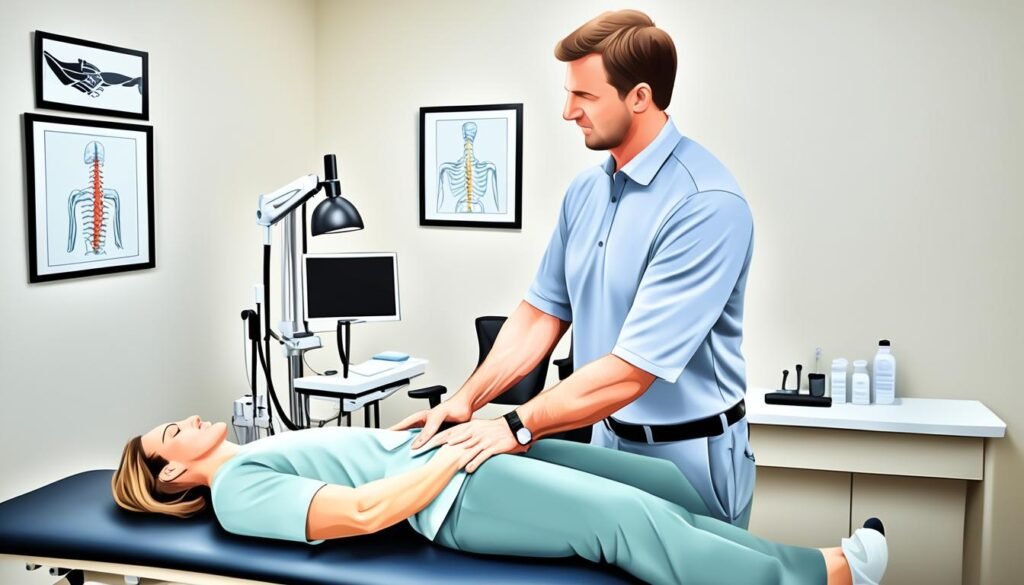
Postoperative Care and Rehabilitation
After surgery for lumbar radiculopathy, patients need a careful recovery plan. This plan includes making changes to their daily activities to prevent harm. They also start a physical therapy plan to get stronger and move better. It’s very important for the patients to follow this plan to heal well and stop the problem from coming back.
Activity Modifications
Right after spine surgery, patients must be careful with their movements. They can’t bend, twist, or lift things, and they should learn to move carefully in bed. These rules help the surgical area heal properly. Sometimes, patients might need to wear a special support device after surgery, depending on what their doctor thinks is best for them.
Physical Therapy and Exercise
Getting physical therapy is key after surgery for lumbar radiculopathy. This program is focused on becoming strong, flexible, and learning the right ways to move. Patients will do exercises that make their core and back muscles stronger. They’ll also learn to be more flexible and keep their balance. Doing all this helps the patient in the long run and decreases the chance of the problem happening again.
Preventing Recurrence
To stop lumbar radiculopathy from coming back, we need to work on risk factors and change our lifestyle. First, keep a healthy weight. Then, focus on your posture and how you sit and stand at work or home. Also, do some regular exercise. This will make your core and back muscles stronger. It lowers the chance of nerves getting pinched. Over time, this can lessen the pain of lumbar radiculopathy.
Lifestyle Changes
Changing how you live can do wonders in keeping lumbar radiculopathy away. Here’s what you should do:
- Maintain a healthy body weight with good food and staying active
- Stop smoking, it’s bad for your back
- Add stretching and strength exercises to your day to make your body more flexible and strong
- Keep up with good posture at work and at play
- Don’t sit still for too long. Take breaks to move around
Ergonomic Adjustments
Changing how you set up your work and home can also help keep lumbar radiculopathy away. Here’s how:
- Make sure your workstation is right for you. Use furniture and tools that can be adjusted for better posture
- Take short breaks to move. Sitting or standing too long can bother your nerves
- Use tools meant for good posture, like lumbar supports or standing desks, to help your lower back
- Avoid movements that stress your back, like lifting, bending, and twisting too much
By making these changes in lifestyle and how you set up your space, you can avoid lumbar radiculopathy from coming back. You can have less pain and more freedom from this tiring issue.
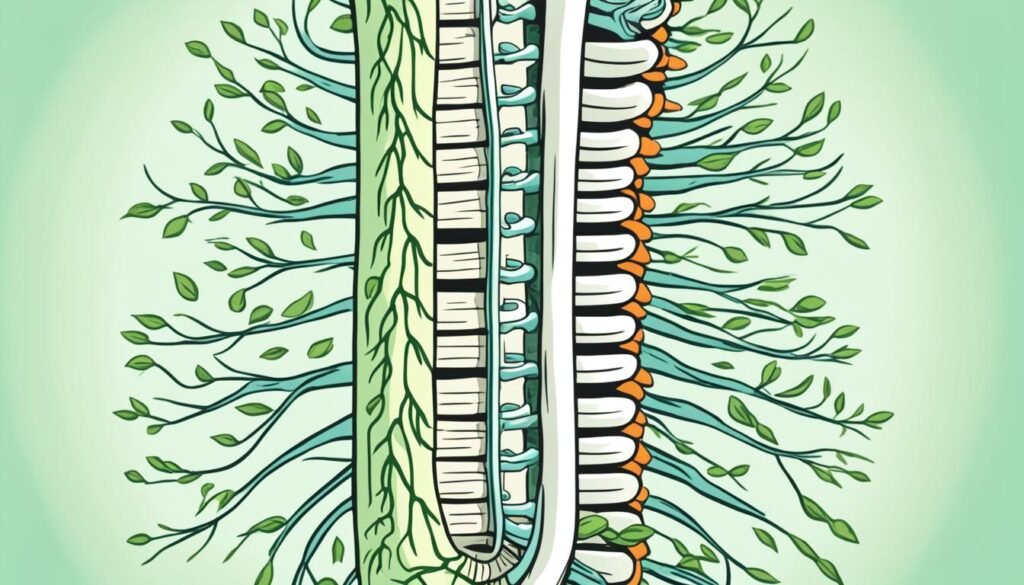
When to Seek Medical Attention
Many cases of lumbar radiculopathy can be treated with basic care. But, some symptoms can be very serious. They need quick medical attention. These include bad motor problems, cauda equina syndrome, and signs of nerve issues.
If these symptoms come on strong, you must see a doctor fast. This could stop more problems and help you heal better.
Red Flag Symptoms
If you notice any of the red flag symptoms for lumbar radiculopathy, get to a doctor right away:
- Severe or progressive muscle weakness in the legs
- Difficulty walking or standing
- Loss of bowel or bladder control (cauda equina syndrome)
- Significant numbness or tingling in the legs or genital area
- Sudden onset of severe pain that is not responding to conservative treatments
These symptoms needing fast medical attention for lumbar radiculopathy could point to severe issues. You should not wait to call your doctor if you notice them.
Conclusion
Lumbar radiculopathy is a common issue that can really affect someone’s life. Luckily, treating it has a lot of effective options. These range from simple treatments to more complex ones.
Working closely with a healthcare provider is key. They can help build a treatment plan just for you. This approach can help ease the pain, make things better, and stop the problem from coming back. Early treatment is important for the best results.
There are many paths to treat this condition. These include things like physical therapy, using medicines, and even surgery. By knowing what’s causing the issue and its signs, you play a big role in your treatment. You can make choices that suit your needs best. This can improve your life a lot.
Choosing care early is crucial. The right mix of treatments can really help. It may ease the pain, help you move better, and keep the issue from happening again.
FAQ
What is lumbar radiculopathy?
Lumbar radiculopathy is when a spinal nerve in your lower back gets compressed. This compression is usually from a herniated disc or bone spurs. You might feel pain, numbness, or weakness in your back, hips, and legs.
What are the common symptoms of lumbar radiculopathy?
People with lumbar radiculopathy often feel back pain and leg pain. They might also have numbness or weakness. The exact symptoms can change based on which nerve is affected.
How is lumbar radiculopathy diagnosed?
Doctors start by doing a full body check to find out what’s wrong. They will check your muscles and how well you can feel things. They might also do tests like MRIs or CT scans. These can show what’s pressing on your nerve.
Other tests, like EMGs, can check your nerve functions. All of this helps to name the condition and figure out how to treat it.
What are the first-line treatment options for lumbar radiculopathy?
The first treatments usually don’t involve surgery. They include physical therapy, exercises, and medications. People might also try things like acupuncture or chiropractic treatments.
What is the role of epidural steroid injections in the management of lumbar radiculopathy?
Epidural steroid injections can help a lot. They put anti-inflammatory medicine right where you need it. This can cut down on swelling and help with pain, especially at the start of the condition.
How does trigger point therapy help with lumbar radiculopathy?
Trigger point therapy targets tight muscle spots with hands-on work or shots. It can make pain better for a short time in people with lumbar radiculopathy. This method might be used together with other treatments.
When is surgical treatment considered for lumbar radiculopathy?
If the first treatments don’t help enough, surgery might be an option. Doctors could do procedures like discectomy or spinal fusion. These aim to solve the main issue causing the nerve pressure and give lasting relief.
What is the importance of postoperative care and rehabilitation for patients with lumbar radiculopathy?
After surgery, patients need careful care and rehab. They might have to change how they do some activities. A lot of focus will be on exercises that build strength and flexibility. Following this plan closely is key to doing well long-term and avoiding the problem coming back.
How can recurrence of lumbar radiculopathy be prevented?
To keep lumbar radiculopathy from coming back, it’s important to work on your health. You should keep a good posture, stay at a healthy weight, and exercise your core and back. These things help prevent further nerve compression.
When should you seek immediate medical attention for lumbar radiculopathy?
“Red flag” symptoms like bad motor problems or bladder trouble need quick medical help. If you’re seeing signs like these, it’s important to see a doctor right away. They can prevent worse issues and help you recover better.
Source Links
- https://www.ncbi.nlm.nih.gov/pmc/articles/PMC6858271/
- https://emedicine.medscape.com/article/95025-treatment
- https://www.hopkinsmedicine.org/health/conditions-and-diseases/radiculopathy
- https://www.uptodate.com/contents/acute-lumbosacral-radiculopathy-treatment-and-prognosis
- https://emedicine.medscape.com/article/95025-workup
- https://comprehensivespine.weillcornell.org/conservative-treatment-versus-surgery-for-lumbosacral-radiculopathy-with-muscle-weakness-and-loss-of-reflexes/
- https://www.atlasneurosurgery.com/blog/7-treatments-for-lumbar-radiculopathy
- https://www.ncbi.nlm.nih.gov/pmc/articles/PMC2667591/
- https://my.clevelandclinic.org/health/treatments/22091-lumbar-epidural-steroid-injection
- https://www.ncbi.nlm.nih.gov/pmc/articles/PMC3265586/
- https://www.ncbi.nlm.nih.gov/pmc/articles/PMC4199211/
- https://www.ncbi.nlm.nih.gov/pmc/articles/PMC5913013/
- https://www.brighamandwomens.org/assets/BWH/patients-and-families/rehabilitation-services/pdfs/operative-spine-acute-bwh.pdf
- https://www.ncbi.nlm.nih.gov/pmc/articles/PMC7170616/
- https://www.choosept.com/guide/physical-therapy-guide-lumbar-radiculopathy-sciatica
- https://www.ncbi.nlm.nih.gov/pmc/articles/PMC10888666/
- https://www.ncbi.nlm.nih.gov/pmc/articles/PMC10878111/
- https://www.healthline.com/health/lumbar-radiculopathy
- https://www.mayoclinichealthsystem.org/hometown-health/speaking-of-health/sciatica-and-radiculopathy-peculiar-names
About The Author

This article is medically reviewed by Dr. Chandril Chugh, Board-Certified Neurologist, providing expert insights and reliable health information.
Dr. Chandril Chugh is a U.S.-trained neurologist with over a decade of experience. Known for his compassionate care, he specializes in treating neurological conditions such as migraines, epilepsy, and Parkinson’s disease. Dr. Chugh is highly regarded for his patient-centered approach and dedication to providing personalized care.
→ Book a consultation to discover which remedies suit your needs best.

